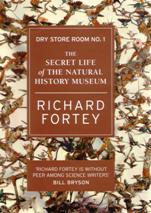Dry Store Room No. 1 – The secret life of the Natural History Museum

Richard Fortey
Published by: Harper Press
Publication date: 2008
ISBN: 978-0-00-720988-0
List price: £20.00
338 pp
www.harpercollins.com
Geologists maturing in years, shall we say, often exhibit an alarming tendency to disappear into a shed and write their memoirs. This is not so surprising, perhaps – many geologists’ lives are filled with wild adventures in disagreeable places that are the stuff of anecdote. On the face of it then, Richard Fortey might seem to lack for material, for at a relatively tender age he slipped neatly into his perfect ecological niche in South Kensington, and never left.
Yet as anyone who has spent time working in a museum will attest, these institutions sit at a point where the wide world narrows to a focus – only to burst out on the other side in an equal and opposite world, full of complexity, like some anti-matter Mandelbrot reflection of the nature its staff study.
But you can trust Richard Fortey to take some hackneyed form, like professional memoirs, and turn it into high art. His purpose here is to conduct a taxonomy of taxonomists – to introduce the reader to the essential job of classifying the world around us through the work of his professional home for his entire career, and those colleagues past and present who are its legends. From the man who dissected whales in a malodorous dry dock, himself permanently pickled, to the taxonomist who left a card catalogue detailing his every sexual conquest (complete with a small sample of pubic hair), Fortey charts a life in science; the life of an institution buffeted by ever-changing - but always stupid - political whims; and the science of taxonomy itself - the vital need to define life’s basic terms if we are ever to hope to understand it before it all dies around us.
This warm hearted, affectionate, indulgent book, full of gentle love and wry asides, springs from the author’s boyish wonder at life and its endless diversity. At its heart lies mysterious Dry Store Room No 1 - the museum’s half-forgotten “miscellanea” drawer; the navel of this world, at once small and huge, where all the fluff collects. It stands as a microcosm within a microcosm; now laid bare for all to know and cherish.
Ted Nield